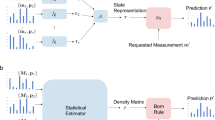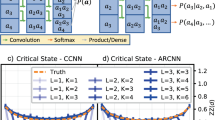Abstract
A major bottleneck in the development of scalable many-body quantum technologies is the difficulty in benchmarking state preparations, which suffer from an exponential ‘curse of dimensionality’ inherent to the classical description of quantum states. We present an experimentally friendly method for density matrix reconstruction based on neural network generative models. The learning procedure comes with a built-in approximate certificate of the reconstruction and makes no assumptions about the purity of the state under scrutiny. It can efficiently handle a broad class of complex systems including prototypical states in quantum information, as well as ground states of local spin models common to condensed matter physics. The key insight is to reduce state tomography to an unsupervised learning problem of the statistics of an informationally complete quantum measurement. This constitutes a modern machine learning approach to the validation of complex quantum devices, which may in addition prove relevant as a neural-network ansatz over mixed states suitable for variational optimization.
This is a preview of subscription content, access via your institution
Access options
Access Nature and 54 other Nature Portfolio journals
Get Nature+, our best-value online-access subscription
$29.99 / 30 days
cancel any time
Subscribe to this journal
Receive 12 digital issues and online access to articles
$119.00 per year
only $9.92 per issue
Buy this article
- Purchase on Springer Link
- Instant access to full article PDF
Prices may be subject to local taxes which are calculated during checkout





Similar content being viewed by others
Data availability
The numerically generated measurements used to produce Fig. 5, the implementation of the generative models and the code to numerically generate the data sets used in this manuscript are available at https://github.com/carrasqu/POVM_GENMODEL.
References
Cirac, J. I. & Zoller, P. Goals and opportunities in quantum simulation. Nat. Phys. 8, 264–266 (2012).
Aspuru-Guzik, A. & Walther, P. Photonic quantum simulators. Nat. Phys. 8, 285–291 (2012).
Bloch, I., Dalibard, J. & Nascimbène, S. Quantum simulations with ultracold quantum gases. Nat. Phys. 8, 267–276 (2012).
Blatt, R. & Roos, C. F. Quantum simulations with trapped ions. Nat. Phys. 8, 277–284 (2012).
Houck, A. A., Türeci, H. E. & Koch, J. On-chip quantum simulation with superconducting circuits. Nat. Phys. 8, 292–299 (2012).
Gross, C. & Bloch, I. Quantum simulations with ultracold atoms in optical lattices. Science 357, 995–1001 (2017).
Vogel, K. & Risken, H. Determination of quasiprobability distributions in terms of probability distributions for the rotated quadrature phase. Phys. Rev. A 40, 2847–2849 (1989).
James, D. F. V., Kwiat, P. G., Munro, W. J. & White, A. G. Measurement of qubits. Phys. Rev. A 64, 052312 (2001).
Roos, C. F. et al. Bell states of atoms with ultralong lifetimes and their tomographic state analysis. Phys. Rev. Lett. 92, 220402 (2004).
Haffner, H. et al. Scalable multiparticle entanglement of trapped ions. Nature 438, 643–646 (2005).
Poulin, D., Qarry, A., Somma, R. & Verstraete, F. Quantum simulation of time-dependent Hamiltonians and the convenient illusion of Hilbert space. Phys. Rev. Lett. 106, 170501 (2011).
Kliesch, M., Barthel, T., Gogolin, C., Kastoryano, M. & Eisert, J. A dissipative quantum Church–Turing theorem. Phys. Rev. Lett. 107, 120501 (2011).
Tóth, G. et al. Permutationally invariant quantum tomography. Phys. Rev. Lett. 105, 250403 (2010).
Moroder, T. et al. Permutationally invariant state reconstruction. New J. Phys. 14, 105001 (2012).
Gross, D., Liu, Y.-K., Flammia, S. T., Becker, S. & Eisert, J. Quantum state tomography via compressed sensing. Phys. Rev. Lett. 105, 150401 (2010).
Cramer, M. et al. Efficient quantum state tomography. Nat. Commun. 1, 149 (2009).
Baumgratz, T., Gross, D., Cramer, M. & Plenio, M. B. Scalable reconstruction of density matrices. Phys. Rev. Lett. 111, 020401 (2013).
Han, Z.-Y. et al. Efficient quantum tomography with fidelity estimation. Preprint at https://arxiv.org/abs/1712.03213 (2017).
Lanyon, B. P. et al. Efficient tomography of a quantum many-body system. Nat. Phys. 13, 1158–1162 (2017).
Flammia, S. T. & Liu, Y.-K. Direct fidelity estimation from few Pauli measurements. Phys. Rev. Lett. 106, 230501 (2011).
da Silva, M. P., Landon-Cardinal, O. & Poulin, D. Practical characterisation of quantum devices without tomography. Phys. Rev. Lett. 107, 210404 (2011).
Aolita, L., Gogolin, C., Kliesch, M. & Eisert, J. Reliable quantum certification of photonic state preparations. Nat. Commun. 6, 8498 (2015).
Gluza, M., Kliesch, M., Eisert, J. & Aolita, L. Fidelity witnesses for fermionic quantum simulations. Phys. Rev. Lett. 120, 190501 (2018).
Torlai, G. et al. Neural-network quantum state tomography. Nat. Phys. 14, 447–450 (2018).
Torlai, G. & Melko, R. G. Latent space purification via neural density operators. Preprint at https://arxiv.org/abs/1801.09684 (2018).
Rocchetto, A., Grant, E., Strelchuk, S., Carleo, G. & Severini, S. Learning hard quantum distributions with variational autoencoders. npj Quantum Inf. 4, 28 (2018).
Deng, D.-L., Li, X. & Das Sarma, S. Quantum entanglement in neural network states. Phys. Rev. X 7, 021021 (2017).
Gao, X. & Duan, L.-M. Efficient representation of quantum many-body states with deep neural networks. Nat. Commun. 8, 662 (2017).
Chen, J., Cheng, S., Xie, H., Wang, L. & Xiang, T. Equivalence of restricted Boltzmann machines and tensor network states. Phys. Rev. B 97, 085104 (2018).
Glasser, I., Pancotti, N., August, M., Rodriguez, I. D. & Cirac, J. I. Neural-network quantum states, string-bond states, and chiral topological states. Phys. Rev. X 8, 011006 (2018).
Goodfellow, I., Bengio, Y. & Courville, A. Deep Learning (MIT Press, 2016).
Raghu, M., Poole, B., Kleinberg, J., Ganguli, S. & Sohl-Dickstein, J. On the expressive power of deep neural networks. In Proceedings of the 34th International Conference on Machine Learning, Vol. 70 of Proceedings of Machine Learning Research (eds Precup, D. & Teh, Y. W.) 2847–2854 (PMLR, 2017).
Levine, Y., Sharir, O., Cohen, N. & Shashua, A. Bridging many-body quantum physics and deep learning via tensor networks. Preprint at https://arxiv.org/abs/1803.09780 (2018).
Nielsen, M. A. & Chuang, I. L. Quantum Computation and Quantum Information 10th edn (Cambridge Univ. Press, 2011).
Penrose, R. Applications of negative dimensional tensors. Combin. Math. Appl. 1, 221–244 (1971).
Carleo, G. & Troyer, M. Solving the quantum many-body problem with artificial neural networks. Science 355, 602–606 (2017).
Deng, D.-L., Li, X. & Das Sarma, S. Machine learning topological states. Phys. Rev. B 96, 195145 (2017).
Nomura, Y., Darmawan, A. S., Yamaji, Y. & Imada, M. Restricted Boltzmann machine learning for solving strongly correlated quantum systems. Phys. Rev. B 96, 205152 (2017).
Clark, S. R. Unifying neural-network quantum states and correlator product states via tensor networks. J. Phys. A Math. Theor. 51, 135301 (2018).
Salakhutdinov, R., Mnih, A. & Hinton, G. Restricted Boltzmann machines for collaborative filtering. In Proceedings of the 24th International Conference on Machine Learning, ICML ‘07 791–798 (ACM, 2007).
Bennett, J. & Lanning, S. The Netflix prize. In KDD Cup and Workshop in Conjunction with KDD (ACM, 2007).
Sutskever, I., Vinyals, O. & Le, Q. V. Sequence to sequence learning with neural networks. In Advances in Neural Information Processing Systems 27 (eds Ghahramani, Z., Welling, M., Cortes, C., Lawrence, N. D. & Weinberger, K. Q.) 3104–3112 (Curran Associates, Red Hook, NY, 2014); http://papers.nips.cc/paper/5346-sequence-to-sequence-learning-with-neural-networks.pdf
Wu, Y. et al. Google’s neural machine translation system: bridging the gap between human and machine translation. Preprint at http://arxiv.org/abs/1609.08144 (2016).
Chiu, C.-C. et al. State-of-the-art speech recognition with sequence-to-sequence models. Preprint at https://arxiv.org/abs/1712.01769 (2018).
Aaronson, S. The learnability of quantum states. Proc. R. Soc. Lond. A Math. Phys. Eng. Sci. 463, 3089–3114 (2007).
Rocchetto, A. et al. Experimental learning of quantum states. Preprint at https://arxiv.org/abs/1712.00127 (2017).
Barends, R. et al. Digital quantum simulation of fermionic models with a superconducting circuit. Nat. Commun. 6, 7654 (2015).
Friedenauer, H., Schmitz, H., Glueckert, J., Porras, D. & Schaetz, T. Simulating a quantum magnet with trapped ions. Nat. Phys. 4, 757–761 (2008).
Kim, K. et al. Quantum simulation of frustrated Ising spins with trapped ions. Nature 465, 590–593 (2010).
Islam, R. et al. Onset of a quantum phase transition with a trapped ion quantum simulator. Nat. Commun. 2, 377 (2011).
Simon, J. et al. Quantum simulation of antiferromagnetic spin chains in an optical lattice. Nature 472, 307–312 (2011).
Bernien, H. et al. Probing many-body dynamics on a 51-atom quantum simulator. Nature 551, 579–584 (2017).
King, A. D. et al. Observation of topological phenomena in a programmable lattice of 1,800 qubits. Nature 560, 456–460 (2018).
Preskill, J. Quantum computing in the NISQ era and beyond. Preprint at https://arxiv.org/abs/1801.00862 (2018).
Peres, A. Quantum Theory: Concepts and Methods (Kluwer, 1995).
Tabia, G. N. M. Experimental scheme for qubit and qutrit symmetric informationally complete positive operator-valued measurements using multiport devices. Phys. Rev. A 86, 062107 (2012).
Acknowledgements
The authors thank G. Vidal, L. Cincio and M. Stoudenmire for discussions and encouragement, and N. Berkovits, A. Reily Rocha and P. Vieira for organizing the ICTP-SAIFR/IFT-UNESP Minicourse on Machine Learning for Many-Body Physics, where this work was started. This research was supported by the Perimeter Institute for Theoretical Physics and the Shared Hierarchical Academic Research Computing Network (SHARCNET). Research at the Perimeter Institute is supported by the Government of Canada through Innovation, Science and Economic Development Canada and by the Province of Ontario through the Ministry of Economic Development, Job Creation and Trade. R.G.M. acknowledges support from NSERC of Canada and a Canada Research Chair. J.C. acknowledges financial and computational support from the AI grant and Canada CIFAR AI (CCAI) Chairs Program. L.A. acknowledges financial support from the Brazilian agencies CNPq (PQ grant no. 311416/2015-2 and INCT-IQ), FAPERJ (JCN E-26/202.701/2018), CAPES (PROCAD2013), FAPESP and the Brazilian Serrapilheira Institute (grant no. Serra-1709-17173).
Author information
Authors and Affiliations
Contributions
All authors contributed significantly to this work.
Corresponding author
Ethics declarations
Competing interests
The authors declare no competing interests.
Additional information
Publisher’s note: Springer Nature remains neutral with regard to jurisdictional claims in published maps and institutional affiliations.
Supplementary information
Supplementary information
Methods and figures
Rights and permissions
About this article
Cite this article
Carrasquilla, J., Torlai, G., Melko, R.G. et al. Reconstructing quantum states with generative models. Nat Mach Intell 1, 155–161 (2019). https://doi.org/10.1038/s42256-019-0028-1
Received:
Accepted:
Published:
Issue Date:
DOI: https://doi.org/10.1038/s42256-019-0028-1
This article is cited by
-
Variational Monte Carlo with large patched transformers
Communications Physics (2024)
-
Language models for quantum simulation
Nature Computational Science (2024)
-
Quantum process tomography with unsupervised learning and tensor networks
Nature Communications (2023)
-
Learning quantum systems
Nature Reviews Physics (2023)
-
Dimension-adaptive machine learning-based quantum state reconstruction
Quantum Machine Intelligence (2023)



